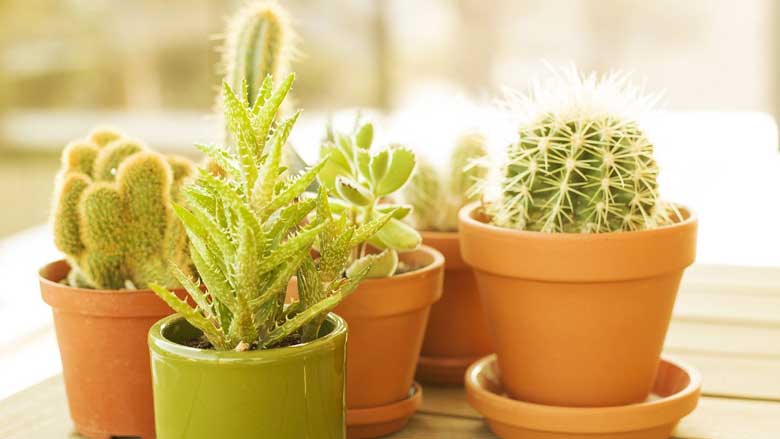Indoor cacti need 4-6 hours of bright sunlight daily and well-drained, sandy soil. Water every 2-4 weeks, allowing the soil to dry out between watering. Fertilize with the right soil and fertilizer. Place in a location with good light and avoid direct sunlight. A good soak in the summer is recommended every 10 days.
If you are looking for an easy-to-care-for houseplant, then cactus plants may be the perfect choice for you!
Cacti are beautiful houseplants that require minimal care and attention, making them the perfect addition to any home or office.
However, there are a few things you should keep in mind when caring for your cactus plants indoors.
In this article, we will provide a complete guide on how to care for indoor cactus plants.
We will discuss everything from watering to fertilizing to pest control. So if you are ready to add some cacti to your home décor, read on!
How to Care For Cactus Indoors
Growing cactus indoors is a fun and easy way to add greenery to your home. Not only are cactus plants low-maintenance, but they also come in various shapes and sizes.
If you’re new to indoor cactus care or just need a refresher, below, you’ll find a detailed guide on how to care for cactus plants indoors.
Indoor Cactus Light Requirements
Cactus plants are desert succulents, so they thrive in hot, dry conditions. Bright sunlight is a must when growing cacti indoors.
If you happen to live somewhere with little natural light-like an apartment or high-rise building-place your indoor cactus near the brightest window available.
Cacti need at least six hours of direct sunlight each day. If your cactus doesn’t receive enough light, it will start to stretch out in search of the sun.
However, too much direct sunlight can cause cactus sunburn.
To prevent sunburn on your indoor cacti, place them in a spot where they will receive morning or late-afternoon sun.
An east or west-facing window is usually a good choice, as it will provide indirect light during the hottest part of the day.
How To Water Indoor Cactus Plants
Unlike most houseplants, you don’t want to keep your indoor cactus soil moist at all times. Overwatering is a common cause of death for these succulents.
Cacti are native to hot and dry regions of the world, which means they’re well-adapted to long periods without water.
Instead of watering them often, cacti thrive when you only water them once their soil is completely dry.
This will be different for every plant and may depend on the season or weather conditions.
Stick your finger in the soil to test if your cactus needs water. If it feels dry to the touch, it’s time to water.
Watering indoor cactus plants is easiest when you use a watering can with a long spout or a watering wand.
This will help you avoid getting the leaves and stems wet, leading to rot and disease.
Indoor Cactus Temperature and Humidity Requirements
Cacti are sensitive to temperature changes and require warm temperatures year-round.
During the summer months, indoor cactus plants thrive in daytime temperatures of 70°F (21°C) or higher.
At night, the temperature should be no lower than 60°F (16°C). Cacti do not do well when the temperature drops below 50°F (12°C).
In the winter, indoor cactus plants should be kept in a warm room with temperatures of 65°F (18°C) or higher.
The ideal humidity level for growing cacti indoors is between 40 to 50%. Cacti don’t do well in high-humidity environments, leading to rot and disease.
How to Repot an Indoor Cactus
Cactus plants are slow-growing, so they don’t need to be repotted very often.
However, you may want to repot your cactus if it has outgrown its current container or the soil is old and nutrient-depleted.
Repotting indoor cacti is best done in spring when the plants come out of their dormant period and just before their growing season begins.
When repotting, use a pot that is only one size larger than the current pot.
If the cactus has been in the same pot for several years, it may be time to transplant it into a new soil mix.
To repot your indoor cactus plant, simply follow these steps:
- Remove the cactus from its current pot
- Gently loosen the soil around the roots with a spoon or fork
- Trim any dead or damaged roots with sharp scissors
- Place the cactus in a new pot and fill in around the roots with fresh soil
- Place the cactus in a sunny spot
- Don’t water the cactus for a few days
After repotting, your cactus may go through a period of adjustment.
It may take a few weeks for the plant to start growing new roots and become re-established in its new pot.
How to Fertilize Indoor Cactus Plants
Cacti don’t need much fertilizer to stay healthy, but you can give them a light feeding every few months during their growing season.
A balanced liquid or organic cactus fertilizer is ideal for fertilizing indoor cacti. Make sure to dilute the fertilizer at half strength before applying it.
To apply the fertilizer, mix it with water and pour it over the soil in the pot. Don’t fertilize a cactus that is wilting or has recently been repotted.
It’s best to fertilize your indoor cacti once every month or two, from spring through midsummer.
If you notice that your cactus is starting to grow too fast, reduce how often you give it fertilizer. If a cactus grows too much, it may become top-heavy and fall over.
Do not fertilize your indoor cacti during their dormant period in winter, as they do not need nutrients.
How to Prune an Indoor Cactus Plant
Cacti don’t need to be pruned, but if a stem or branch is damaged or broken off, you can remove it with sharp scissors.
When cutting cactus stems and branches, make sure the cut is clean and straight. If any jagged edges are left behind on the plant, they may rot.
When pruning cacti, sterilize your scissors between cuts by dipping them in rubbing alcohol.
This will prevent the spread of disease from one part of the plant to another.
Also, be careful not to get sharp spines on your skin or clothing when handling a cactus plant.
Common Pests and Diseases of Indoor Cacti
Cacti are generally easy to grow, but they can encounter problems from pests and diseases.
These annoyances will not usually kill a cactus plant, but it’s best to treat them as soon as possible so the problem doesn’t worsen.
Here are some of the most common pests and diseases that can affect indoor cacti:
Mealybugs
Mealybugs are tiny, white insects that look like cottony blobs.
They cluster on the stem of a cactus plant and suck out its juices, causing stunted growth and wilting leaves. Mealybugs also secrete a sticky substance called “honeydew,” which attracts ants and encourages sooty mold to grow on the plant.
If you see mealybugs on your cactus, treat them with neem oil or insecticidal soap.
Spider Mites
Spider mites are microscopic pests that live and feed on the underside of cactus leaves.
They cause small yellow spots to appear on the surface of the leaves, which eventually become brown and fall off.
You can also see cobwebs around infested plants as the mites spin their webs to protect themselves from predators.
If you suspect your cactus is infested with spider mites, consider applying neem oil or insecticidal soap to address the issue.
Scale Insects
Scale insects are tiny bugs that attach themselves to the stems of cacti and suck out their juices.
They form white, brown, or black bumps on the plant’s stem, eventually spreading all over it.
The affected area may also turn yellow or brown. Scale insects can be hard to remove, as they’re tough and have no legs to walk on.
Treat scale insects on your cactus with neem oil or insecticidal soap if you see scale insects.
If all else fails, cut off the affected part of the plant and dispose of it in the trash (not your compost pile).
Root Rot
Root rot is a fungal disease that attacks the roots of cacti and other succulents.
It’s often caused by overwatering, which leads to fungi growing in the soil and drowning out your plant’s roots.
If your cactus has root rot, the leaves will wilt and turn brown. The plant may also lose its color and start to smell bad.
If you think your cactus has root rot, repot it in fresh soil and let it dry for a few days.
Don’t water the plant until the top of the soil is dry to the touch. You can also treat root rot with fungicide or neem oil.
Fungal Diseases
Cacti can also get infected with various types of fungi, which can cause discoloration and decay.
Fungal diseases are often caused by overwatering but can also occur due to poor lighting or a lack of ventilation.
If you observe any indications of fungal growth on your cactus, address it by applying neem oil or a suitable fungicide.
Powdery Mildew
This is a white, powdery growth that appears on cacti leaves.
It’s caused by a lack of ventilation or poor lighting conditions and can cause stunted growth and yellowing leaves.
If you see any signs of powdery mildew on your cactus, treat it with neem oil or fungicide.
3 Easy to Care For Indoor Cacti
Now that you know how to care for indoor cacti, here are three easy-to-grow types of cactus plants:
Fishbone Cactus (Disocactus Anguliger)
The Fishbone cactus, also known as the Ric Rac cactus, is an epiphytic cactus that grows in the rainforests of Mexico and Central America.
The primary stems are usually woody, and the secondary stems are flat, fleshy, and serrated or lobed in form.
The flowers of this night-blooming cactus are white or pale yellow and have a pleasant, sweet fragrance.
Moon Cactus (Gymnocalycium Mihanovichii)
The Gymnocalycium mihanovichii (Moon cactus) is a compact, spherical cactus indigenous to South America.
The most popular types are mutant strains that lack chlorophyll and have red, orange, or yellow coloration.
These strains are generally grafted onto the Hylocereus cactus, and the resultant plant is known as a “Moon Cactus.”
Christmas Cactus (Schlumbergera)
The Schlumbergera, commonly known as the Christmas cactus or Thanksgiving cactus, is a small, epiphytic cactus native to Brazil.
It flowers in the fall (October-December) and is often given as a gift during the Christmas season.
The flowers are usually red, pink, or white and have a sweet fragrance.
Final Thoughts
Indoor cactus plants are low maintenance and are very easy to care for.
Most cactus varieties will thrive indoors if you provide the right growing conditions.
If you don’t have much space or want to add some greenery to your home without doing much work, then indoor cacti may be the perfect choice!







